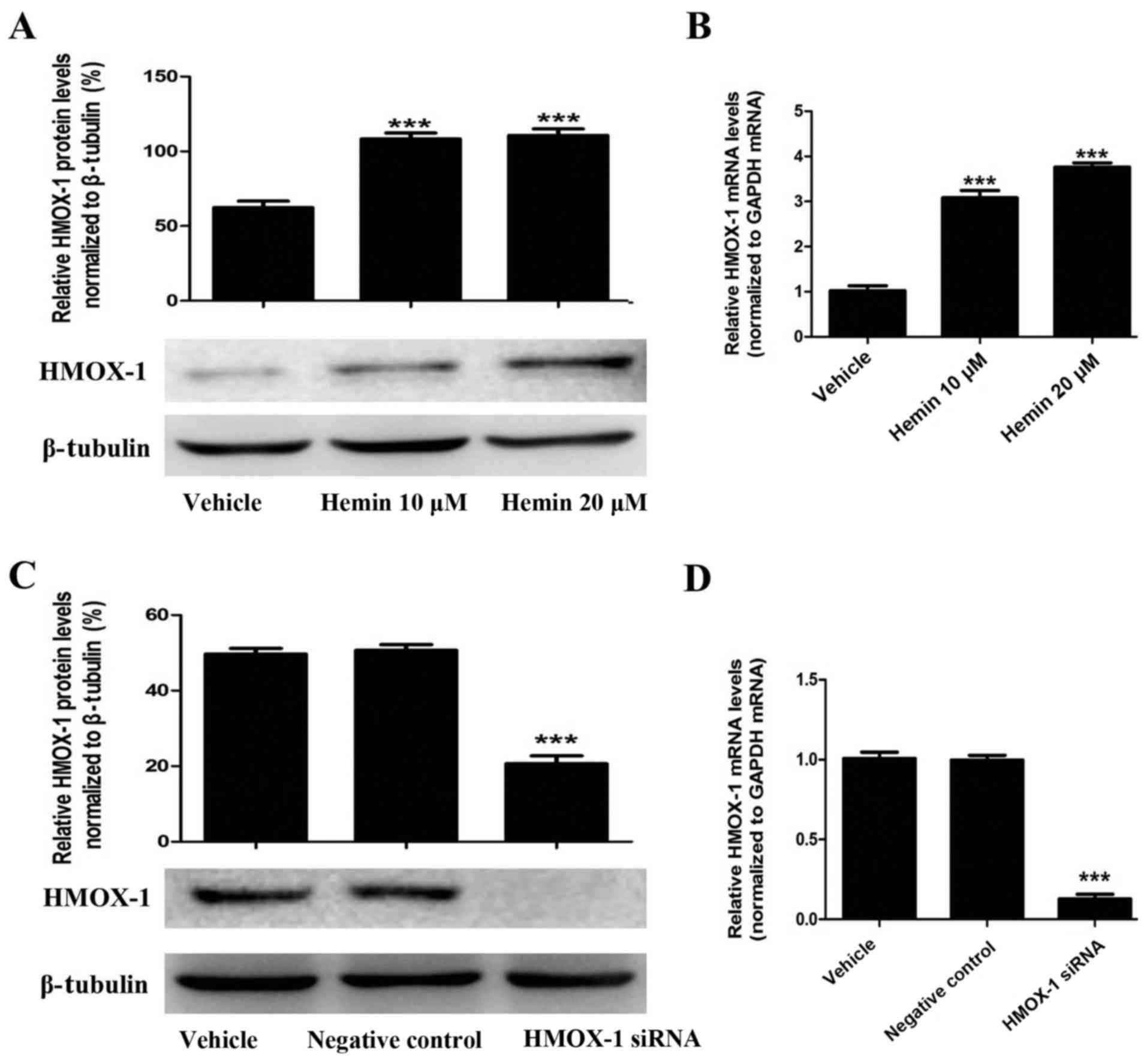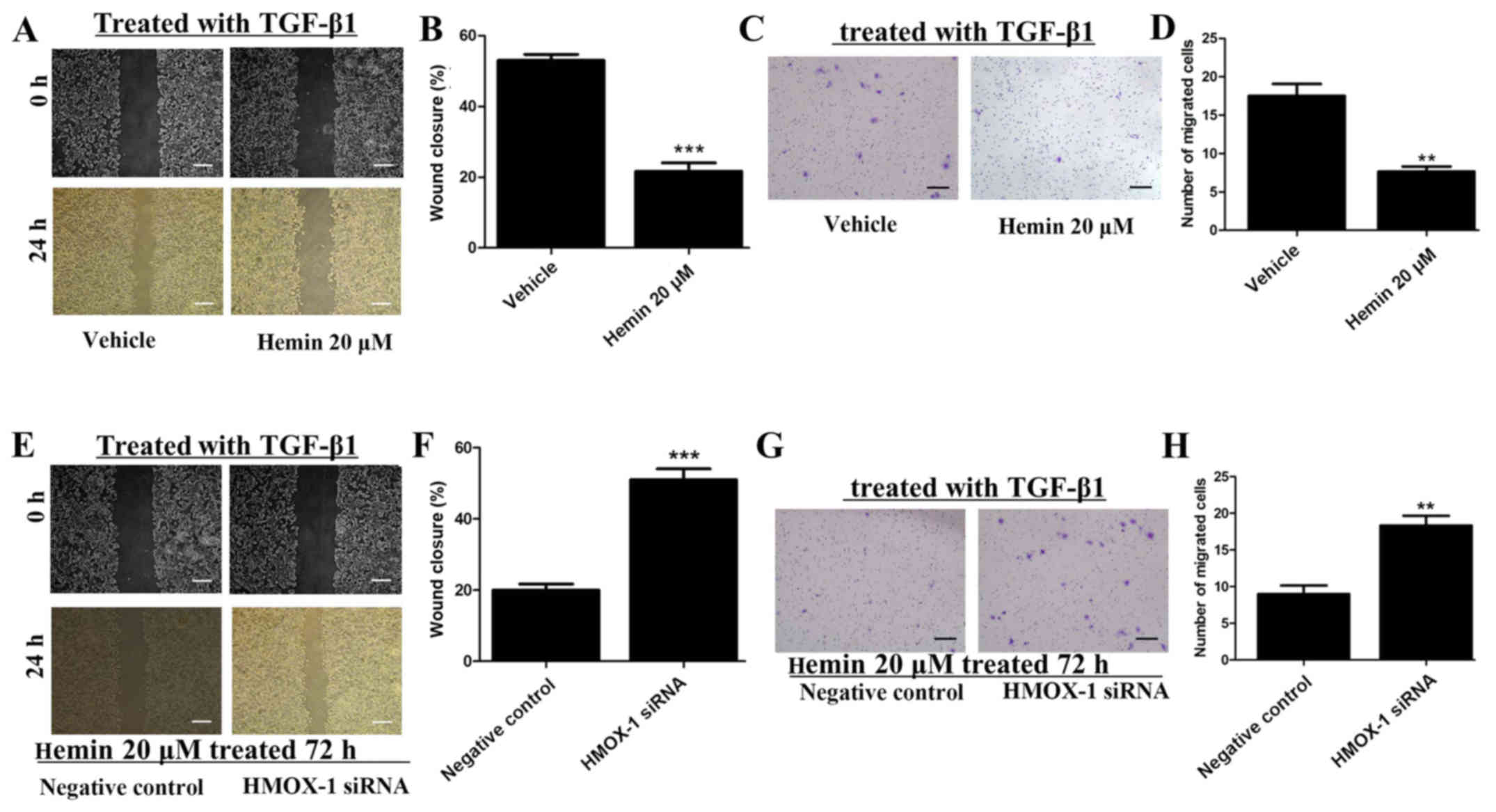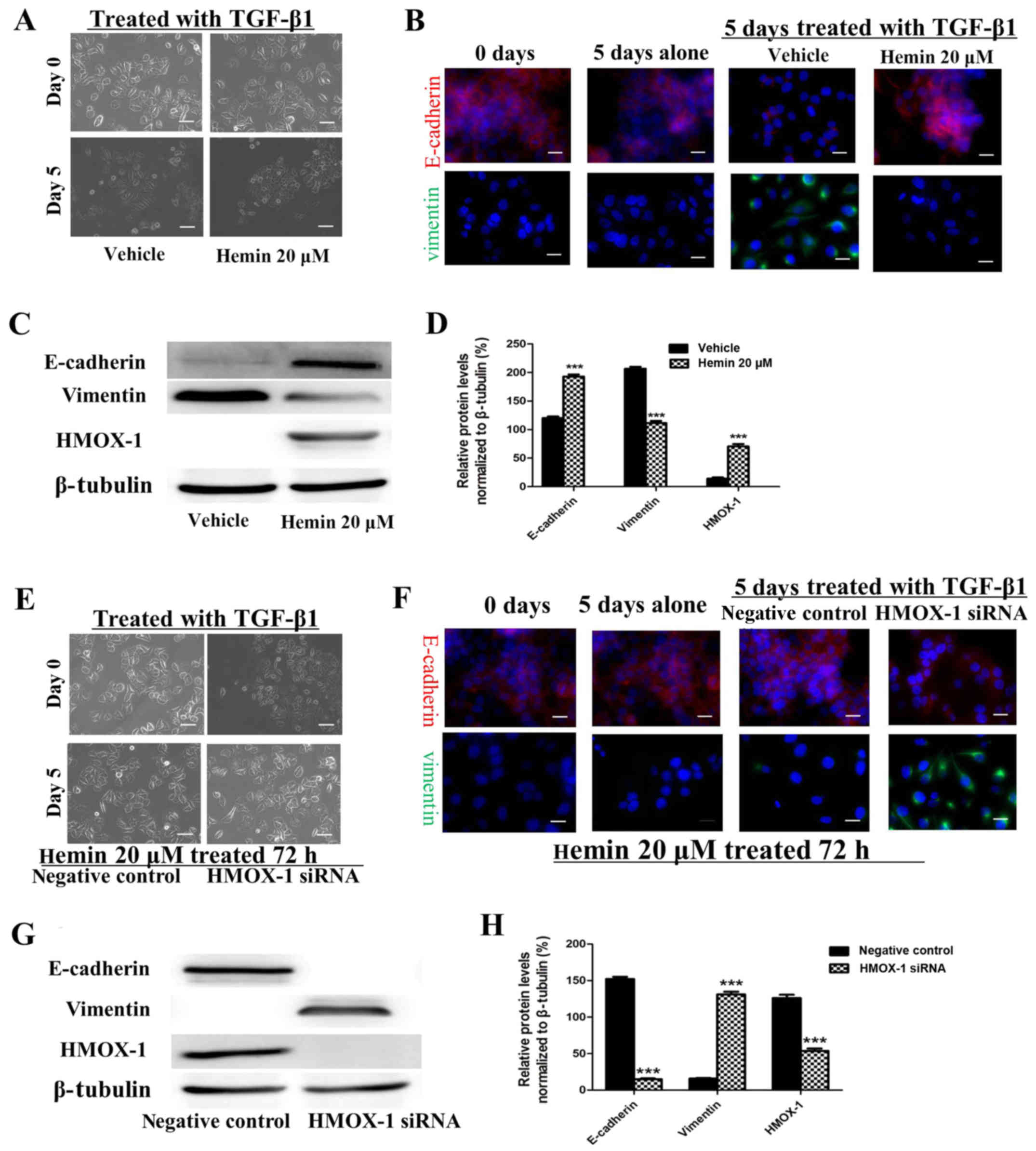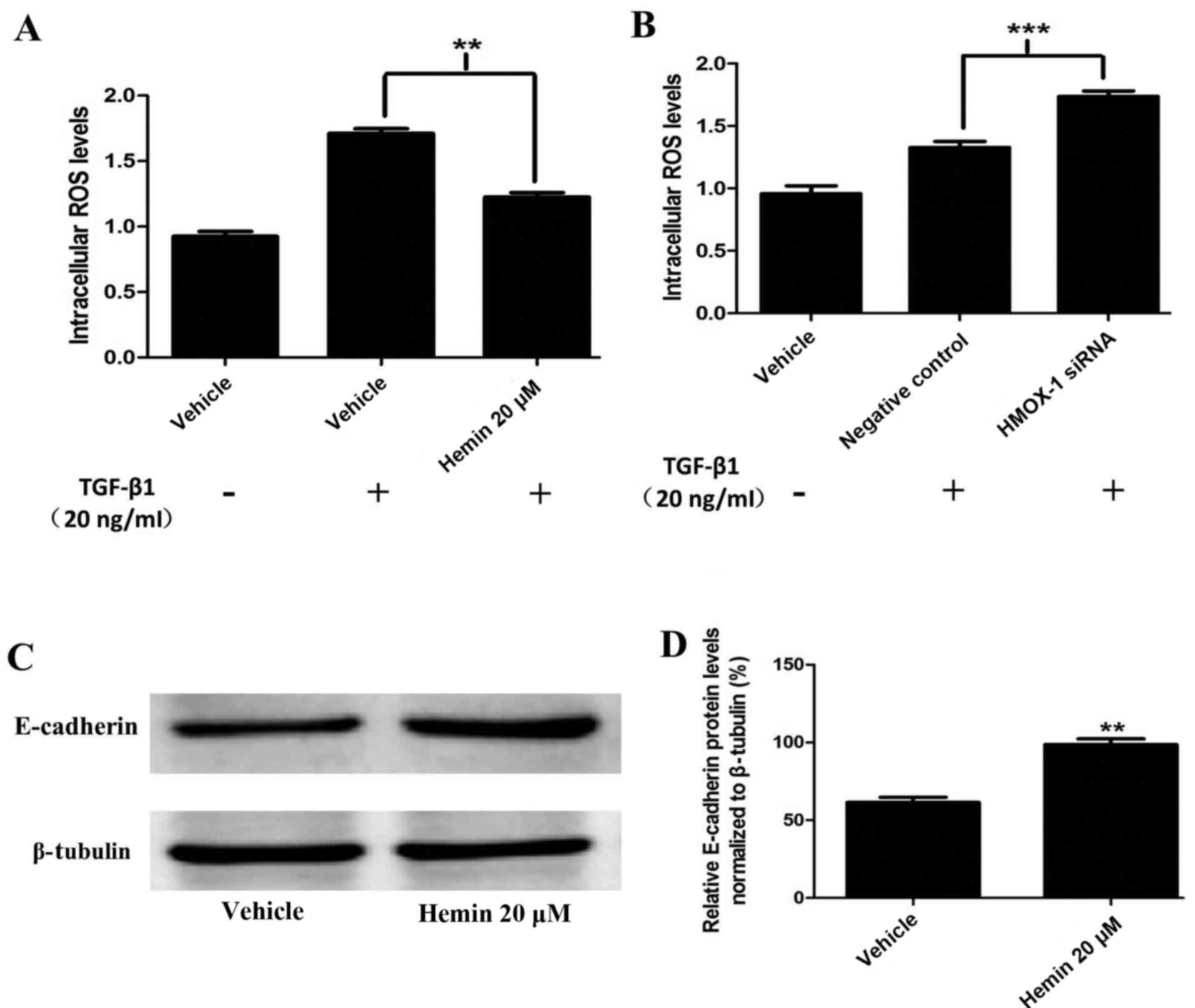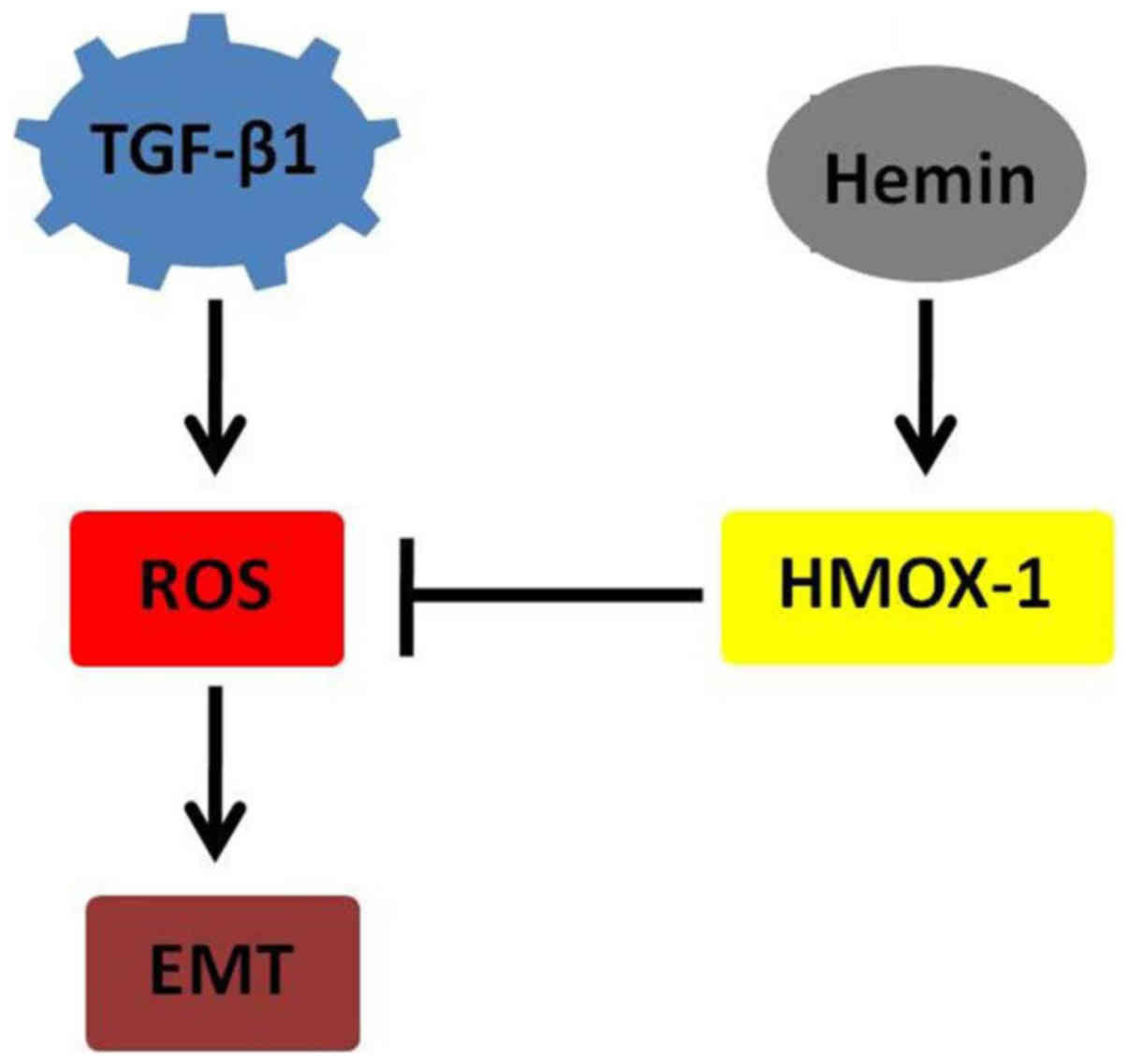HMOX-1 inhibits TGF-β-induced epithelial-mesenchymal transition in the MCF-7 breast cancer cell line
- Authors:
- Published online on: June 14, 2017 https://doi.org/10.3892/ijmm.2017.3027
- Pages: 411-417
-
Copyright: © Zhu et al. This is an open access article distributed under the terms of Creative Commons Attribution License.
Abstract
Introduction
Tumor metastasis is a major clinical challenge that accounts for the vast majority of cancer-related deaths. Breast cancer patients have high rates of development of metastatic disease even following successful primary tumor resection and adjuvant therapy. An estimated 30% of node-negative breast cancer patients and a larger percentage of node-positive breast cancer patients develop metastatic disease despite receiving standard therapy (1). Approximately 90% of breast cancer deaths are caused by the local invasion and distant metastasis of tumor cells (2). The path of metastatic colonization is a complex and multi-faceted process. To develop metastasis, primary cancer cells must invade and escape the physical barriers at the primary site.
Epithelial-mesenchymal transition (EMT) is a process whereby cancer cells lose their epithelial properties to acquire a mesenchymal phenotype and become motile and invasive, which is linked to metastasis (3–5). The expression of the inter-cellular epithelial adhesion molecule E-cadherin is decreased, and markers of mesenchymal cells, such as α-smooth muscle actin (α-SMA), N-cadherin and vimentin, are upregulated during EMT (3). EMT has also been connected to the induction of cancer stem cells and drug resistance, suggesting that EMT may underlie many biological processes of cancer development (4). Transforming growth factor-β (TGF-β) is secreted by many cell types and directly stimulates the production of the extracellular matrix and microenvironment by both normal and cancer cells (6). As tumors progress, TGF-β induces neoplastic cell invasiveness and metastasis by promoting EMT in many cancer cell types (7). Reactive oxygen species (ROS) are radicals, ions or molecules that have a single unpaired electron in their outermost shell and are constantly generated inside cells by dedicated enzyme complexes or as by-products of redox reactions (8). A recent study suggested that ROS play an important role in TGF-β-induced EMT. A significant increase was found to occur in intracellular ROS upon TGF-β stimulation (9). The release of TGF-β-dependent ROS is responsible for the phosphorylation of Smad2, p38 MAPK and extracellular signal-regulated kinase 1/2 (ERK1/2) and accounts for the upregulation of α-SMA and fibronectin and the repression of E-cadherin (9).
The cellular defense system against oxidative stress is composed of a subset of antioxidant proteins. Heme oxygenase-1 (HMOX-1) is a microsomal enzyme that is induced in response to cellular stress and diverse oxidative stimuli (10). The enzymatic activity of HMOX-1 produces CO, ferrous iron and biliverdin. Therefore, HMOX-1 can reduce oxidative stress, attenuate inflammatory responses and lower the rate of apoptosis (10). HMOX-1 can also inhibit the migration and invasion of prostate cancer cells and renal tubular epithelial cells (11). Additionally, the biological activity of HMOX-1 reduces ROS generation (10). However, the effect of HMOX-1 on EMT, which plays a critical role in the metastasis of breast cancer, requires further research.
In this study, we found that the HMOX-1 inducer hemin inhibited ROS production in the MCF-7 breast cancer cell line. Furthermore, we observed that hemin inhibited the migration, invasion and EMT of MCF-7 breast cancer cells. These results show that HMOX-1 may function as an important player in breast cancer metastasis.
Materials and methods
Cell culture
The MCF-7 human breast cancer cell line was purchased from the American Type Culture Collection (ATCC; Manassas, VA, USA) and cultured in Dulbecco's modified Eagle's medium (DMEM) supplemented with 10% fetal bovine serum (FBS), 1% penicillin and 1% streptomycin (both from Gibco, Karlsruhe, Germany) in a 5% CO2 atmosphere at 37°C.
Transfection of siRNAs
The HMOX-1 siRNA was synthesized by RiboBio Biotechnology (Guangzhou, China). The HMOX-1 siRNA sequences were sense, 5′-CCAGCAACAAAGUGCA AGAdTdT-3′ and antisense, 3′-dTdTGGUCGUUGUUUCACG UUCU-5′. Breast cancer cells were transfected with 50 nM of siRNA for 8 h using the RNAiMAX transfection agent (Invitrogen, Carlsbad, CA, USA) according to the manufacturer's instructions.
Reverse transcription-quantitative (real-time) polymerase chain reaction (RT-qPCR) for mRNA quantification
Total RNA was extracted from the cells using TRIzol (Invitrogen), and cDNA was synthesized from 1,000 ng of total RNA using the PrimeScript RT reagent kit (Takara, Dalian, China) following the manufacturer's instructions. Quantitative PCR was performed on the Bio-Rad CFX 96 real-time PCR machine (Bio-Rad Laboratories, Inc., Hercules, CA, USA) using SYBR® Premix Ex Taq™ II (Tli RNaseH Plus) (Takara). The primer sequences were as follows: HMOX-1-F, 5′-TACCACATCTAT GTGGCCCTG-3′ and HMOX-1-R, 5′-TGGCTGGTGTGTA GGG GAT-3′, and glyceraldehyde 3-phosphate dehydrogenase (GAPDH)-F, 5′-GCACCGTCAAGGCTGAGAAC-3′ and GAPDH-R, 5′-TGGTGAAGACGCCAGTGGA-3′. Data analysis was performed using the comparative Ct method with the Bio-Rad Manager 2.1 software (Bio-Rad Laboratories, Inc.).
Western blotting
The cells were lysed in RIPA lysis buffer (Cell Signaling Technology, Boston, MA, USA) supplemented with protease inhibitor (Roche, Basel, Switzerland). The total protein concentration was determined using a BCA kit (Keygen, Nanjing, China). Equal amounts of protein (35 μg) for each group were separated by sodium dodecyl sulfate (SDS)-polyacrylamide gel electrophoresis, transferred to polyvinylidene difluoride (PVDF) membranes (Millipore, Bedford, MA, USA), and blotted using anti-HMOX-1 (ab52947; Abcam, Cambridge, UK), anti-E-cadherin (#3195), anti-vimentin (#5741) or anti-β-tubulin (#2128) antibodies (Cell Signaling Technology). The bands were visualized using the Luminol reagent (Thermo Pierce, Waltham, MA, USA) and imaged using the GE ImageQuant Las 4000 Mini (GE Healthcare, Fairfield, CT, USA).
Migration and invasion assays of MCF-7 breast cancer cells
The migratory ability of the MCF-7 cells was determined using a wound-healing assay. Briefly, MCF-7 cells were treated with hemin (20 μM; Sigma-Aldrich, St. Louis, MO, USA) for 72 h and then seeded into 6-well plates (60,000 cells/well). When the cells were almost 100% confluent, the monolayer was wounded using a sterilized 200-μl disposable pipette tip to scratch a wound in each well. Then, the cells were treated with TGF-β1 (10 ng/ml; Peprotech, Rocky Hill, NJ, USA). The scratch wounds were visualized under a microscope (Zeiss Axio Observer Z1; Zeiss, Jena, Germany).
The cell invasion assay was performed in the BD BioCoat™ Matrigel™ Invasion Chamber (8-μm pore size) (BD Bioscience, Franklin Lakes, NJ, USA). MCF-7 cells were treated with hemin (20 μM) for 72 h. Then, the cells were added to the upper chambers with 200 μl of serum-free DMEM medium, and the lower chambers were filled with 500 μl of DMEM medium supplemented with TGF-β1 (10 ng/ml). After 12 h, non-migrating cells were removed from the upper chamber, and the migrating cells adhering to the lower surface of the membrane were fixed with 4% formaldehyde and quantified by 0.1% crystal violet staining.
Immunofluorescence assay
The cells were seeded into 24-well plates and treated with TGF-β1 (10 ng/ml) for 5 days. The cells were washed in phosphate-buffered saline (PBS), fixed in 4% formaldehyde for 15 min, permeabilized with 0.1% Triton X-100 for 10 min, and blocked with 0.1% BSA for 1 h. Then, the cells were incubated with an anti-E-cadherin (#3195) or anti-vimentin (#5741) antibody (Cell Signaling Technology) overnight at 4°C. After washing with PBS 3 times, the cells were incubated with a fluorescent-conjugated secondary antibody (red, A11008; green, A11010; Life Technologies, Grand Island, NY, USA) for 1 h at room temperature and stained with 4′,6-diamidino-2-phenylindole (DAPI; Roche) for 10 min. Images were acquired using a fluorescence microscope (Carl Zeiss Axio Observer Z1, Jena, Germany).
Fluorescent ROS assay
ROS generation was analyzed after staining the cells with the fluorescent probe dichlorofluorescein-DA (DCFDA) (Sigma-Aldrich). The cells were incubated with or without hemin following TGF-β1 treatment. Then, the cells were loaded with DCFDA (20 mM) in Hank's Balanced Salt Solution (HBSS; Gibco, Karlsruhe, Germany) at 37°C for 30 min in the dark. After washing with HBSS, the DCFDA fluorescence of each well was measured at 485 nm (excitation) and 528 nm (emission) with a Multi-Mode Microplate Reader (BioTek, Winooski, VT, USA).
Statistical analysis
The data are expressed as the mean ± SD. Differences between the treatment groups and the control group were assessed with Student's t-test using GraphPad Prism version 5.0 (GraphPad, San Diego, CA, USA). Statistically significant differences are indicated as P<0.05, P<0.01 and P<0.001.
Results
Hemin induces HMOX-1 expression in the MCF-7 breast cancer cell line
To evaluate the effect of HMOX-1 on TGF-β-induced EMT, we treated MCF-7 cells with an HMOX-1 inducer (hemin, 20 μM) and then examined whether hemin induced HMOX-1 expression using RT-qPCR and western blotting. Hemin treatment significantly upregulated HMOX-1 mRNA and protein expression in the MCF-7 cells (Fig. 1A and B). Then, we confirmed that the HMOX-1 siRNA knocked down hemin-induced HMOX-1 expression by RT-qPCR and western blotting (Fig. 1C and D).
Hemin inhibits the migration and invasion of TGF-β-treated MCF-7 cells
Wound-healing and cell invasion assays were performed to investigate the effect of HMOX-1 on the migration and invasion of TGF-β1-treated MCF-7 cells after incubating the cells with or without 20 μM of hemin. Hemin significantly inhibited the migratory ability of the MCF-7 cells in the wound-healing assay (Fig. 2A and B). Additionally, upregulation of HMOX-1 by hemin significantly inhibited the invasiveness of the MCF-7 cells (Fig. 2C and D). MCF-7 cells were treated with hemin (20 μM) for 72 h and then transfected with the HMOX-1 siRNA or a negative control. Then, we induced the migration and invasion of the MCF-7 cells with TGF-β1 (10 ng/ml). The HMOX-1 siRNA attenuated the inhibitory effect of hemin on the MCF-7 cells and promoted the migration (Fig. 2E and F) and invasion (Fig. 2G and H) of the hemin-treated MCF-7 cells.
Hemin inhibits the TGF-β-induced EMT in MCF-7 cells
The morphological changes characteristic of cells undergoing EMT are accompanied by a shift in gene expression from an epithelial to a mesenchymal repertoire. To determine whether HMOX-1 inhibits this shift, both the expression and cellular distribution of selected EMT markers were investigated by immunofluorescence staining and western blotting in the TGF-β1-treated MCF-7 cells. The MCF-7 cells exhibited decreased E-cadherin expression and higher expression of the mesenchymal marker vimentin after TGF-β1 treatment (10 ng/ml) (Fig. 3B–D). These changes were reversed by sequentially treating the cells with 20 μM of hemin. These results implied that HMOX-1 inhibited the EMT progression in MCF-7 cells. Our data showed that HMOX-1 prevented EMT changes in the MCF-7 cells. To confirm this finding, we performed a loss-of-function study in which the HMOX-1 siRNA was used to verify the effect of HMOX-1 on EMT. After exposure to hemin (20 μM) for 72 h, the cells were transfected with the HMOX-1 siRNA or a negative control RNA and then treated with TGF-β1 (10 ng/ml) for 5 days and subjected to western blotting and immunofluorescence assays. The results of both the western blotting and immunofluorescence assays showed that hemin inhibited the TGF-β-induced EMT in MCF-7 cells through the upregulation of E-cadherin and downregulation of vimentin. In contrast, diminished E-cadherin expression and increased vimentin expression were observed in the HMOX-1 siRNA-treated cells compared to the vehicle group (Fig. 3F–H). These results indicated that the HMOX-1 siRNA attenuated the inhibitory effect of hemin on the TGF-β-induced EMT in the MCF-7 cells.
Hemin reduces ROS generation and induces E-cadherin expression in MCF-7 cells
To determine the role of HMOX-1 as a TGF-β-responsive ROS inhibitor, we treated the cells with TGF-β1 (20 ng/ml). ROS generation was measured using DCFDA and a fluorescence spectrometer. The hemin-treated MCF-7 cells had diminished ROS production compared to the control cells (Fig. 4A). These results were confirmed by silencing HMOX-1 with the HMOX-1 siRNA. The HMOX-1 siRNA-transfected group showed increased TGF-β1-mediated ROS generation compared to the negative control group (Fig. 4B). Our findings suggested that HMOX-1 regulated the ROS levels in MCF-7 cells. Interestingly, we observed that hemin induced E-cadherin protein expression in the normal MCF-7 cells (Fig. 4C and D).
Discussion
Metastasis is responsible for ~90% of cancer-associated patient mortality (2). Although a great deal of effort has been expended, progress in the research on metastasis is stagnating due to the lack of effective tools to elucidate the complex network of signaling pathways that drive this multistep process. EMT is a phenotypic conversion linked to metastasis that was originally defined as a morphological conversion occurring at specific sites in embryonic epithelia to give rise to individual migratory cells (3). Recent studies have found that EMT plays a role in enhancing the invasive and metastatic behaviors of tumor cells. During the EMT process, epithelial cells gain mesenchymal properties and exhibit reduced intercellular adhesion and increased motility. Sequentially, these cells break through the basal membrane and migrate long distances (4). In this study, we showed that HMOX-1 inhibited TGF-β-induced EMT in the MCF-7 breast cancer cell line.
HMOX-1 is an anti-inflammatory and antioxidant protein. The role of HMOX-1 in cancer is controversial. Because this protein is a potent inducer of vascular endothelial growth factor (VEGF), which is a crucial factor that governs tumor angiogenesis, HMOX-1 has also been recognized as an angiogenesis exciter and a tumor-metastasis supporter (12). Alternatively, HMOX-1 has been reported to suppress the invasive capacity of breast cancer cells via downregulating matrix metallopeptidase 9 (MMP9) (13). In this study, we found that HMOX-1 was induced by hemin in the breast cancer MCF-7 cell line and inhibited the invasion and migration of TGF-β-treated MCF-7 breast cancer cells.
TGF-β is a primary inducer of EMT and plays a double role in cancer. TGF-β inhibits the proliferation and induces the apoptosis of cancer cells in the early stages of tumorigenesis. However, this protein can also promote invasion and metastasis during later tumor development (7). TGF-β induces EMT by activating E-cadherin repressors and Smad2/3 (14). Additionally, TGF-β can induce EMT via Smad-independent pathways, such as the phosphatidylinositol 3-kinase (PI3K), Akt, mitogen-activated protein kinase (MAPK) and Rho family GTPase pathways (15). Our data suggest a tumor-suppressor role for HMOX-1 in breast cancer. HMOX-1 expression was increased via hemin stimulation, and in turn the EMT induced by TGF-β was inhibited in the hemin-treated breast cancer cells. The inhibitory effect of hemin on the TGF-β-induced EMT was significantly attenuated by trans-fection of the HMOX-1 siRNA into hemin-treated MCF-7 breast cancer cells.
Recent observations suggest that ROS play an important role in TGF-β-induced EMT (16–18). Upon TGF-β stimulation, a significant increase was found to occur in intracellular ROS. TGF-β-dependent ROS release was demonstrated to be responsible for the phosphorylation of Smad2 and p38 MAPK, the upregulation of α-SMA and fibronectin and the downregulation of E-cadherin (13). Therefore, HMOX-1 may impact the EMT process by regulating the release of ROS and their dependent pathways (Fig. 5). Thus, modulating HMOX-1 levels may be a strategy through which to regulate TGF-β-induced EMT.
Interestingly, we found that HMOX-1 enhanced E-cadherin expression in normal MCF-7 cells. Epithelial cells communicate with their neighboring cells through the extension of either lamellipodia or filopodia, which couple to the intracellular cytoskeleton, trigger specific signaling pathways, and contribute to cell adhesion (19,20). E-cadherin plays a major role in intercellular adhesion. Additionally, the role of E-cadherin as a tumor suppressor has been observed in a variety of cancers, including prostate, ovarian, gastric and breast cancers (21–24). Cancer cells with low E-cadherin expression levels have been suggested to be more invasive, although the signaling pathways involved in this modulation are unknown. Future study should focus on the potential molecular partners with which HMOX-1 interacts to induce the cellular morphological changes.
In conclusion, we found that HMOX-1 inhibited TGF-β-induced EMT by regulating ROS release in MCF-7 cells. Our results imply that HMOX-1 plays an antitumor role in the breast and acts as a target for cancer therapy.
Acknowledgments
This study was supported by the National Natural Science Foundation of China (no. 81172337).
References
|
Libson S and Lippman M: A review of clinical aspects of breast cancer. Int Rev Psychiatry. 26:4–15. 2014. View Article : Google Scholar : PubMed/NCBI | |
|
Criscitiello C, André F, Thompson AM, De Laurentiis M, Esposito A, Gelao L, Fumagalli L, Locatelli M, Minchella I, Orsi F, et al: Biopsy confirmation of metastatic sites in breast cancer patients: Clinical impact and future perspectives. Breast Cancer Res. 16:2052014. View Article : Google Scholar : PubMed/NCBI | |
|
De Craene B and Berx G: Regulatory networks defining EMT during cancer initiation and progression. Nat Rev Cancer. 13:97–110. 2013. View Article : Google Scholar : PubMed/NCBI | |
|
Sharma RR, Pollock K, Hubel A and McKenna D: Mesenchymal stem or stromal cells: A review of clinical applications and manufacturing practices. Transfusion. 54:1418–1437. 2014. View Article : Google Scholar : PubMed/NCBI | |
|
Kupcova Skalnikova H: Proteomic techniques for characterisation of mesenchymal stem cell secretome. Biochimie. 95:2196–2211. 2013. View Article : Google Scholar : PubMed/NCBI | |
|
Akhurst RJ and Hata A: Targeting the TGFβ signalling pathway in disease. Nat Rev Drug Discov. 11:790–811. 2012. View Article : Google Scholar : PubMed/NCBI | |
|
Li B, Wen G, Zhao Y, Tong J and Hei TK: The role of TGFBI in mesothelioma and breast cancer: Association with tumor suppression. BMC Cancer. 12:2392012. View Article : Google Scholar : PubMed/NCBI | |
|
Brown DI and Griendling KK: Regulation of signal transduction by reactive oxygen species in the cardiovascular system. Circ Res. 116:531–549. 2015. View Article : Google Scholar : PubMed/NCBI | |
|
Krstić J, Trivanović D, Mojsilović S and Santibanez JF: Transforming growth factor-beta and oxidative stress interplay: Implications in tumorigenesis and cancer progression. Oxid Med Cell Longev. 2015:6545942015. View Article : Google Scholar | |
|
Jozkowicz A, Was H and Dulak J: Heme oxygenase-1 in tumors: Is it a false friend? Antioxid Redox Signal. 9:2099–2117. 2007. View Article : Google Scholar : PubMed/NCBI | |
|
Gueron G, Giudice J, Valacco P, Paez A, Elguero B, Toscani M, Jaworski F, Leskow FC, Cotignola J, Marti M, et al: Heme-oxygenase-1 implications in cell morphology and the adhesive behavior of prostate cancer cells. Oncotarget. 5:4087–4102. 2014. View Article : Google Scholar : PubMed/NCBI | |
|
Cherrington JM, Strawn LM and Shawver LK: New paradigms for the treatment of cancer: The role of anti-angiogenesis agents. Adv Cancer Res. 79:1–38. 2000. View Article : Google Scholar : PubMed/NCBI | |
|
Chen HW, Chao CY, Lin LL, Lu CY, Liu KL, Lii CK and Li CC: Inhibition of matrix metalloproteinase-9 expression by docosahexaenoic acid mediated by heme oxygenase 1 in 12-O-tetradecanoylphorbol-13-acetate-induced MCF-7 human breast cancer cells. Arch Toxicol. 87:857–869. 2013. View Article : Google Scholar : PubMed/NCBI | |
|
Zavadil J, Cermak L, Soto-Nieves N and Böttinger EP: Integration of TGF-beta/Smad and Jagged1/Notch signalling in epithelial-to-mesenchymal transition. EMBO J. 23:1155–1165. 2004. View Article : Google Scholar : PubMed/NCBI | |
|
Vincent T, Neve EP, Johnson JR, Kukalev A, Rojo F, Albanell J, Pietras K, Virtanen I, Philipson L, Leopold PL, et al: A SNAIL1-SMAD3/4 transcriptional repressor complex promotes TGF-beta mediated epithelial-mesenchymal transition. Nat Cell Biol. 11:943–950. 2009. View Article : Google Scholar : PubMed/NCBI | |
|
Zhang KH, Tian HY, Gao X, Lei WW, Hu Y, Wang DM, Pan XC, Yu ML, Xu GJ, Zhao FK, et al: Ferritin heavy chain-mediated iron homeostasis and subsequent increased reactive oxygen species production are essential for epithelial-mesenchymal transition. Cancer Res. 69:5340–5348. 2009. View Article : Google Scholar : PubMed/NCBI | |
|
Lim SO, Gu JM, Kim MS, Kim HS, Park YN, Park CK, Cho JW, Park YM and Jung G: Epigenetic changes induced by reactive oxygen species in hepatocellular carcinoma: Methylation of the E-cadherin promoter. Gastroenterology. 135:2128–2140. 2140.e1–2140.e8. 2008. View Article : Google Scholar : PubMed/NCBI | |
|
Lochter A, Galosy S, Muschler J, Freedman N, Werb Z and Bissell MJ: Matrix metalloproteinase stromelysin-1 triggers a cascade of molecular alterations that leads to stable epithelial-to-mesenchymal conversion and a premalignant phenotype in mammary epithelial cells. J Cell Biol. 139:1861–1872. 1997. View Article : Google Scholar | |
|
Baum B and Georgiou M: Dynamics of adherens junctions in epithelial establishment, maintenance, and remodeling. J Cell Biol. 192:907–917. 2011. View Article : Google Scholar : PubMed/NCBI | |
|
Herszterg S, Leibfried A, Bosveld F, Martin C and Bellaiche Y: Interplay between the dividing cell and its neighbors regulates adherens junction formation during cytokinesis in epithelial tissue. Dev Cell. 24:256–270. 2013. View Article : Google Scholar : PubMed/NCBI | |
|
Tomita K, van Bokhoven A, van Leenders GJ, Ruijter ET, Jansen CF, Bussemakers MJ and Schalken JA: Cadherin switching in human prostate cancer progression. Cancer Res. 60:3650–3654. 2000.PubMed/NCBI | |
|
Sawada K, Mitra AK, Radjabi AR, Bhaskar V, Kistner EO, Tretiakova M, Jagadeeswaran S, Montag A, Becker A, Kenny HA, et al: Loss of E-cadherin promotes ovarian cancer metastasis via alpha 5-integrin, which is a therapeutic target. Cancer Res. 68:2329–2339. 2008. View Article : Google Scholar : PubMed/NCBI | |
|
Tang B, Peng ZH, Yu PW, Yu G and Qian F: Expression and significance of Cx43 and E-cadherin in gastric cancer and metastatic lymph nodes. Med Oncol. 28:502–508. 2011. View Article : Google Scholar | |
|
Chao YL, Shepard CR and Wells A: Breast carcinoma cells re-express E-cadherin during mesenchymal to epithelial reverting transition. Mol Cancer. 9:1792010. View Article : Google Scholar : PubMed/NCBI |



